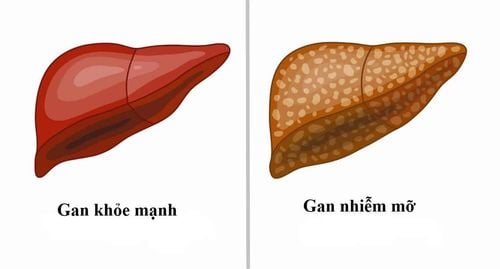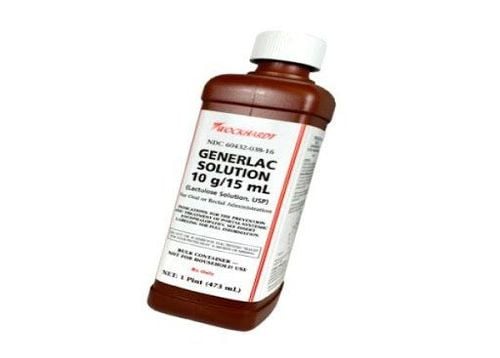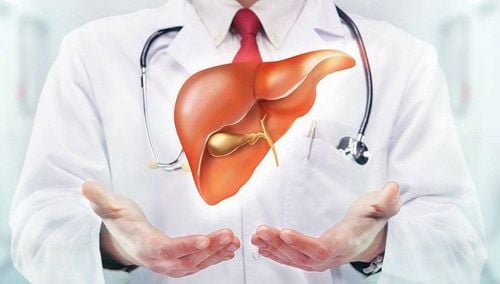This is an automatically translated article.
The article was professionally consulted by Specialist Doctor I Le Nguyen Hong Tram - Gastroenterologist - Department of Medical Examination & Internal Medicine - Vinmec Nha Trang International General Hospital. The doctor has many years of experience in the examination and treatment of gastrointestinal diseases, especially gastrointestinal - hepatobiliary diseases, gastrointestinal endoscopy and general internal diseases.Non-alcoholic fatty liver disease (NAFLD) includes a number of liver diseases, ranging from simple fatty liver to nonalcoholic steatohepatitis (NASH) and cirrhosis. Currently, non-alcoholic fatty liver disease is considered the most common cause of elevated liver enzymes. The best way to prevent and treat the disease is to know the progression and early symptoms of the disease.
1. What is non-alcoholic fatty liver?
Nonalcoholic fatty liver disease (NAFLD) manifests itself in the following signs:Patients have fatty liver on imaging (abdominal ultrasound, CT scan, MRI...) or on histology. Often accompanied by risk factors such as obesity, type 2 diabetes, dyslipidemia. Excluding other causes of secondary fatty liver such as alcohol consumption, hepatitis C infection, lipodystrophy, Wilson's disease, malnutrition, prolonged parenteral nutrition, drugs (amiodarone, tamoxifen, methotrexate, corticosteroids, valproate, anti-retroviral...), acute fatty liver in pregnant women, congenital metabolic defects. The reason the term “non-alcoholic” is used is because NAFLD and NASH both occur in people who do not drink alcohol. All stages of nonalcoholic fatty liver disease share the same markers of fat accumulation in the liver cells. In non-alcoholic steatohepatitis (NASH) fatty deposits are associated with a high degree of hepatitis and liver fibrosis. Progression of fatty liver disease can lead to severe consequences if not diagnosed and treated promptly.
2. Risk subjects of non-alcoholic fatty liver

People with dyslipidemia: a high percentage of fat molecules (triglycerides) in the blood, low HDL cholesterol are also prone to non-alcoholic fatty liver disease. The rate of NAFLD in the group of patients with dyslipidemia is about 59%.
The rate of nonalcoholic fatty liver disease and the degree of liver disease increase with age, the risk of NAFLD in men is 2 times higher than that of women, the disease also varies between ethnic groups. This is explained by genetic differences.
3. Progression of non-alcoholic fatty liver
The progression of NAFLD begins with the most basic stage, fatty liver. Fatty liver disease is the first abnormal development of NAFLD. Simple fatty liver involves the accumulation of fat in hepatocytes without inflammation or fibrosis. In fact, fat is made up of fat molecules (triglycerides) that accumulate in very small sacs located in liver cells. Fat accumulation in liver cells is not the same as the fat cells (adipocytes) that make up our body. Fatty liver is inherently a benign disease because it does not cause any significant liver damage by itself.However, the next and more dangerous stage of NAFLD is steatohepatitis (NASH). Fortunately, only a small fraction of patients with fatty liver are at risk of developing NASH. Fatty hepatitis involves the accumulation of fat in liver cells as in hepatitis, and inflamed cells can cause liver cell damage. While fatty liver disease is a benign disease, steatohepatitis can lead to irreversible cirrhosis. Cirrhosis is the most severe and final stage of NAFLD progression.
>>See more: Advances in the treatment of nonalcoholic steatohepatitis - Article written by Master, Doctor Mai Vien Phuong - Gastrointestinal endoscopist - Department of Examination & Internal Medicine - Hospital Vinmec Central Park International General Hospital. Doctor has nearly 10 years of experience in the field of Gastrointestinal Endoscopy.
4. Non-alcoholic fatty liver symptoms

Warning signs to watch out for are loss of appetite, loss of appetite, prolonged fatigue and nausea and bloating. Abdominal pain in NAFLD and NASH is usually due to distention of the liver due to an enlarged liver or an inflamed liver. However, the early stage is usually asymptomatic, when fatty liver persists, the common symptoms are discreet hepatomegaly, liver enzymes and alkaline phosphatase moderately increased; During this time, there are usually no symptoms.
In liver diseases caused by alcohol consumption, hepatitis B and C, which have very severe symptoms and can lead to acute liver failure, were not found in NAFLD and NASH.
Classic signs of insulin resistance are often based on clinical findings in NAFLD and NASH. As noted above, obesity (especially in the abdomen) is the most common sign. Furthermore, patients with long-term type 2 diabetes are more susceptible to complications such as retinopathy, high blood pressure, kidney failure, and coronary artery disease. Acanthosis nigricans is also a classic sign of insulin resistance and is common in children with NASH.
Cirrhosis usually occurs late (from 50 to 60 years of age) and is considered a consequence of many years of NASH. Signs of reversible cirrhosis include an enlarged, stiff liver, small, star-shaped blood vessels in the skin, palmar erythema, pale fingernails, hair loss, hair loss, and venous distention in the abdomen and breasts. In women, menstrual periods are irregular or absent, and in men, the testicles are small and the breasts are enlarged. Signs of decompensated cirrhosis include all of the above (except that the liver is not large but atrophy), in addition to other symptoms such as lower extremity edema, ascites, bleeding from esophageal varices, and confusion. mixed.
Currently, nonalcoholic fatty liver disease is the most common cause of elevated liver enzymes. The prevalence of NAFLD in Europe is about 35%, in Asia it is about 25%.
Approximately 15 - 30% of the population has NAFLD, up to 12 - 40% of these patients will progress to non-alcoholic steatohepatitis (NASH), and about 15 - 25% of NASH patients will develop to cirrhosis, about 7% of cirrhotic patients will progress to liver cancer.
Patients with fatty liver can go to Vinmec International General Hospital for examination and treatment. Vinmec gathers a team of well-trained, professional and experienced gastroenterology specialists; system of modern equipment, meeting international standards; Professional service quality, high efficiency in diagnosis and treatment.
Please dial HOTLINE for more information or register for an appointment HERE. Download MyVinmec app to make appointments faster and to manage your bookings easily.














